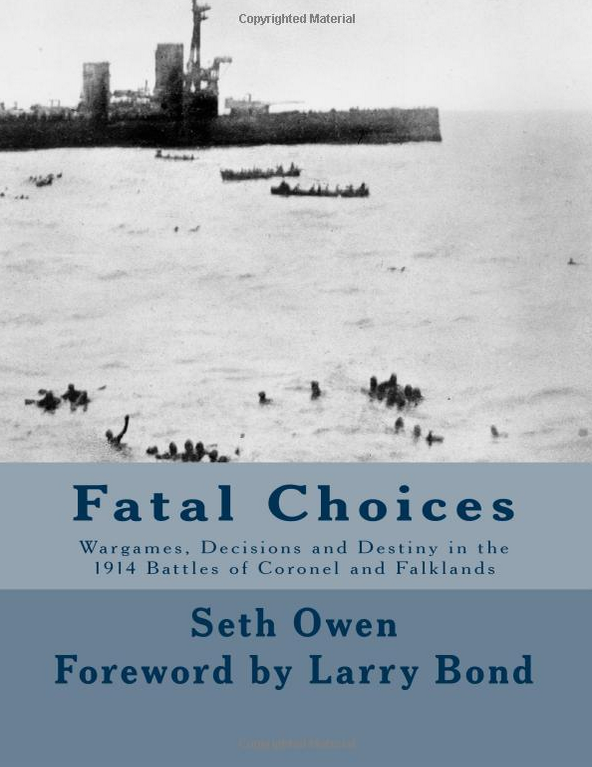 As I mentioned in a brief post a while back, I recently backed a Kickstarter for a book project called “Fatal Choices: Wargames Decisions and Destiny in the 1914 Battles of Coronel and Falklands” by Seth Owen, who posts in the forums as Wargamer55. After putting some time into the book, I felt compelled to write up a review as I believe Seth has not only made an important contribution to the naval wargaming community, but crafted a book that will be of interest to anyone, gamer or non-gamer, who wishes to deepen their understanding of WWI naval warfare.
As I mentioned in a brief post a while back, I recently backed a Kickstarter for a book project called “Fatal Choices: Wargames Decisions and Destiny in the 1914 Battles of Coronel and Falklands” by Seth Owen, who posts in the forums as Wargamer55. After putting some time into the book, I felt compelled to write up a review as I believe Seth has not only made an important contribution to the naval wargaming community, but crafted a book that will be of interest to anyone, gamer or non-gamer, who wishes to deepen their understanding of WWI naval warfare.
First off, his selected subject matter is very timely, coming on the heels of the 100th anniversary of these early WWI naval battles. These battles were something of a proving ground for the new technologies that had been in development for the last few decades; wireless communications, centralized fire control, and the battle cruiser would all play a part in these dramatic actions. Fatal Choices covers the naval battles resulting from the desperate attempt of a squadron of German ships to make its way back to Germany from their distant China station by crossing the Pacific and rounding the Cape Horn, and the British attempts to catch and destroy them. As such, it provides excellent insight into how those technological developments affected naval war in WWI, and serves as a novel teaching tool. The central thesis of this work is that naval war games provide a unique way to gain insight into historical events. They can do this not only by putting a player in the shoes of the historical commanders, but also by serving as a tool to analyze the various “what-if” scenarios that inevitably develop around key historical events.
The book is really broken up into three main parts. The first part, consisting of the first 7 chapters, serves as the “set-up” for the rest of the book. These chapters deal with the geopolitical situation leading up to the breakout of war, the technical and developmental details of the ships involved, and also includes short biographies of some of the key players involved on both the German and British sides of the conflict. Of particular interest to me was Chapter 7, where the author covers a brief history of naval gaming, describes some of the major historical rule sets, and discusses the ways in which these rules can be applied.
The second portion of the book are focused on the various battles resulting from the British effort to hunt down the German squadron. All of the chapters in this section follow a generally similar pattern; they each describe either one of the historical battles or an alternative “what-if” version of a battle, and then describe the results of playing through that scenario using the various rule sets that were described earlier in the book. The results of these play-throughs are interesting, as more often than not they tend to match the actual outcomes for the historical battles, and show that the “what-if” theories don’t hold up to close scrutiny. Each of these chapters, of course, challenge the reader to “Try if for themselves!” using the resources supplied in the book.
The final portion of the book is dedicated to the rules, ship pages, and forms needed to play the scenarios presented earlier in the book. Two different rule sets (NAVTAC and Fear God & Dread Nought) are included, allowing the player two different ways to re-enact history. These rule sets are fairly detailed and therefore somewhat complex, but that is necessary in order to do a reasonable job at capturing the realities of naval combat during this era. In order to play these scenarios, the reader will need to make copies of some of the pages of the book, in order to avoid marking up the examples in the appendices. PDF versions of these resources are available for free from the book’s website for those that prefer that option, and sets of cardboard counters are also available for those that wish to go that extra step.
In conclusion, this is a complete package, providing background, the description of historical events, and the tools to re-create those events using just the contents of the book. It does all this while being both imminently accessible to novice war gamers while remaining interesting to veterans like me. For those that would like to dig deeper, Fatal Choices also includes a detailed bibliography that will be of great help in directing further reading. As one of my history profs once told me, a good way to judge a historical work is by the bibliography; Fatal Choices does not disappoint in this area! Overall, I highly recommend this book to anyone who has an interest in WWI and/or naval history.

Pingback: Forum Newsletter 12 |